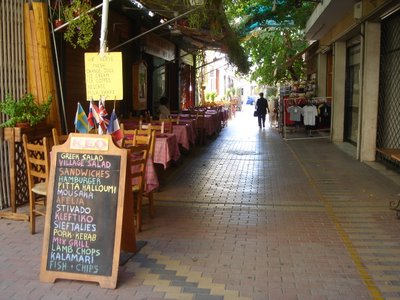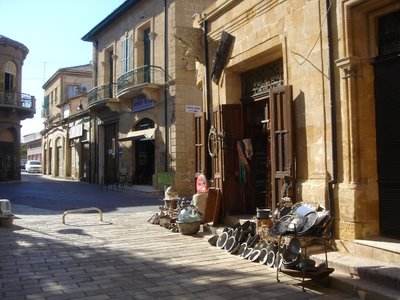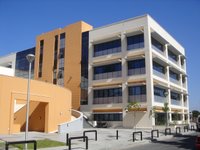 The previous meeting of the EU Leonardo-funded project ISLES had taken place in Bucharest this past April. Now it was the turn of another partner to host the meeting - at the Cyprus College in Nicosia. So the Leeds Met participants in this project (myself and Ah-Lian who also had been in Bucharest) flew on 3.October to the airport of Larnaca on Cyprus, as the airport of Nikosia is still closed, due to the occupation by Turkey.
The previous meeting of the EU Leonardo-funded project ISLES had taken place in Bucharest this past April. Now it was the turn of another partner to host the meeting - at the Cyprus College in Nicosia. So the Leeds Met participants in this project (myself and Ah-Lian who also had been in Bucharest) flew on 3.October to the airport of Larnaca on Cyprus, as the airport of Nikosia is still closed, due to the occupation by Turkey.As we boarded the Cyprus Airways plane in Amserdam, a highly guarded official walked by us. His body guards held machine guns in their hands - this guy must have been a big shot. I did not recognise him, but he was probably a politician.
The island of Cyprus is divided: the officially recognised Cyprus is the southern part, with predominantly Greek heritage, while the northern part, invaded by Turkey in 1974 and occupied since then, is not internationally recognised. Cyprus (excluding the Turkish part) is a new member of the EU since 2004, and as Turkey is moving towards EU membership, there is hope that the "Cyprus question" moves toards being resolved in the near future.
Nicosia, or Lefkosia as it is also called, is a divided city: into the Greek southern part, and the Turkish northern part. The southern part is full of thriving business, but seems also to be spoilt by many ugly concrete buildings. Many cars pollute the air, and there are very few sidewalks. Nobody walks here, it is almost like in Los Angeles. The centre is nice, with several pedestrian streets, restaurants, shops.
 View over Nicosia.
View over Nicosia. In the centre of Nicosia.
In the centre of Nicosia. Border within the city - from the Greek part.
Border within the city - from the Greek part. The same border part - seen from the north side, the Turkish part of Nicosia.
The same border part - seen from the north side, the Turkish part of Nicosia. Village atmosphere in the Turkish part of Nikosia.
Village atmosphere in the Turkish part of Nikosia.
 The ISLES meeting began on 4.October with an evening conference, with speakers Roberto Cavaliere and Nicos Lygeros. It then continued for two more days of meetings, reports, and discussions.
The ISLES meeting began on 4.October with an evening conference, with speakers Roberto Cavaliere and Nicos Lygeros. It then continued for two more days of meetings, reports, and discussions. 
Of course an important aspect of these EU related travels is to get to know the culture of the host country. Our hosts had arranged for nice dinners in restaurants, to sample the great local food. On the first evening we went to a fish restaurant Paragadi, who served a huce meal of "Meze": that is all kinds of appetizers brought to the table, where everyone could share them. They kept bringing so many things, that when the main dish came, nobody was hungry anymore.
The 2nd evening Lena and I went to another recommended restaurant: Plaka (see review on Fodors.
 Hard to find by foot, especially at night. But what a treat: 32 dishes were included in the "Meze", for about 10 Cyprus pound (20 US dollars) per person. The owner who sat at the door entrance, proudly showed us a picture of former German chancellor Helmut Kohl dining in this restaurant! We also discover a picture of pianist Cyprien Katsaris, who is the cousin of Marius, my former colleague from RSC whom I just had met two weeks ago.
Hard to find by foot, especially at night. But what a treat: 32 dishes were included in the "Meze", for about 10 Cyprus pound (20 US dollars) per person. The owner who sat at the door entrance, proudly showed us a picture of former German chancellor Helmut Kohl dining in this restaurant! We also discover a picture of pianist Cyprien Katsaris, who is the cousin of Marius, my former colleague from RSC whom I just had met two weeks ago.We stayed one more day until Sunday, so that on Saturday we could rent a car and travel around the whole island. The landscape reminded me a lot of Southern California in summer: very dry, sandy, small patches of brown plants, trying to grow in the hot October sun (30 deg C). Somewhat similar to the Mojave desert. Small villages are perched onto hill sides, surrounded by olive trees. The Cyprus olives taste much more bitter than their French or Italian counterparts - maybe because of the dry sandy ground?
 The village Lefkara in the South of Cyprus.
The village Lefkara in the South of Cyprus. Colorful houses in Lefkara.
Colorful houses in Lefkara. Renovated Roman Amphitheatre near the Apollo temple in Southern Cyprus.
Renovated Roman Amphitheatre near the Apollo temple in Southern Cyprus. Paphos Castle at night.
Paphos Castle at night.